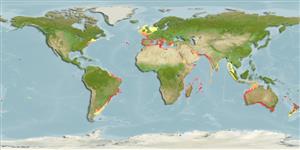Common names from other countries
Classification / Names / Names
Nomes comuns | Sinónimos | Catalog of Fishes (gen., sp.) | ITIS | CoL | WoRMS
Environment: milieu / climate zone / depth range / distribution range
Ecologia
Pelágico(a,os,as); intervalo de profundidade 0 - 200 m (Ref. 1134). Subtropical; 15°C - 27°C (Ref. 1134)
Warm waters of all oceans.
Length at first maturity / Tamanho / Peso / Idade
Maturity: Lm ? range ? - ? cm Max length : 0.3 cm TL macho/indeterminado; (Ref. 1610)
Minimum depth from Ref. 3475. Marine, planktonic; not deeper than 200 m (Ref. 1134). Prefers neritic ambience (Ref. 3531).
Life cycle and mating behavior
Maturidade | Reprodução | Desova | Ovos | Fecundidade | Larvas
Members of the class Appendicularia are protandrous hermaphrodites. Life cycle: Eggs develop into hatchlings (feeding juveniles) before turning into adults.
Kott, P. 2005. (Ref. 1134)
Categoria na Lista Vermelha da IUCN (Ref. 130435)
Categoria CITES (Ref. 108899)
Not Evaluated
Not Evaluated
Utilização humana
| FishSource |
Ferramentas
Mais informação
Nomes comunsSinónimosPredadoresReproduçãoMaturidadeDesovaFecundidadeOvosDesenvolvimento dos ovos
Idade/Tamanho
Crescimento
Comprimento-peso
Comprimento-comprimento
Morfologia
Larvas
Abundância
Fontes da internet
Estimates based on models
Preferred temperature
(Ref.
115969): 15.8 - 26.9, mean 20.6 (based on 332 cells).
Vulnerabilidade
Low vulnerability (10 of 100).
Categoria de preço
Unknown.
